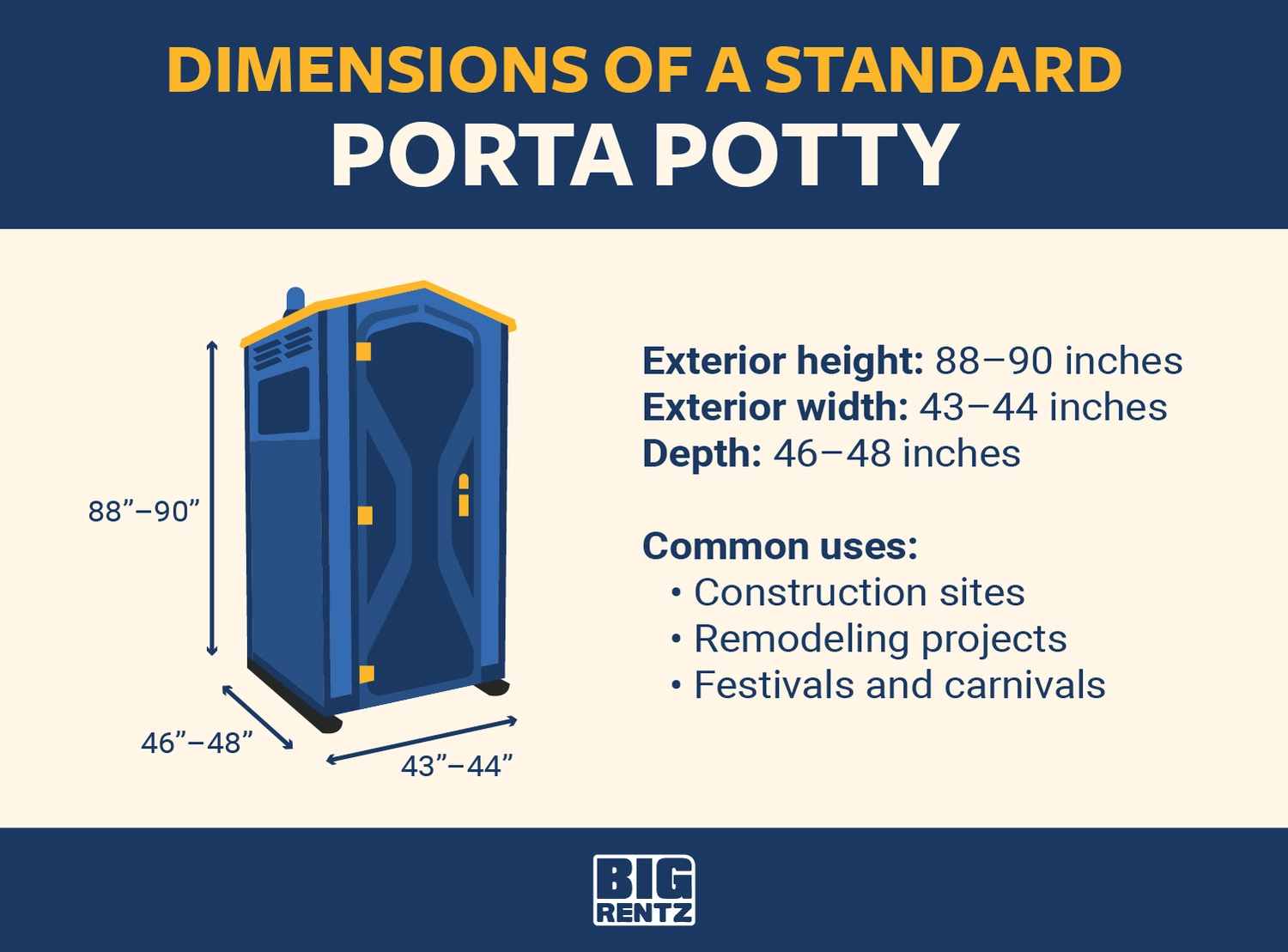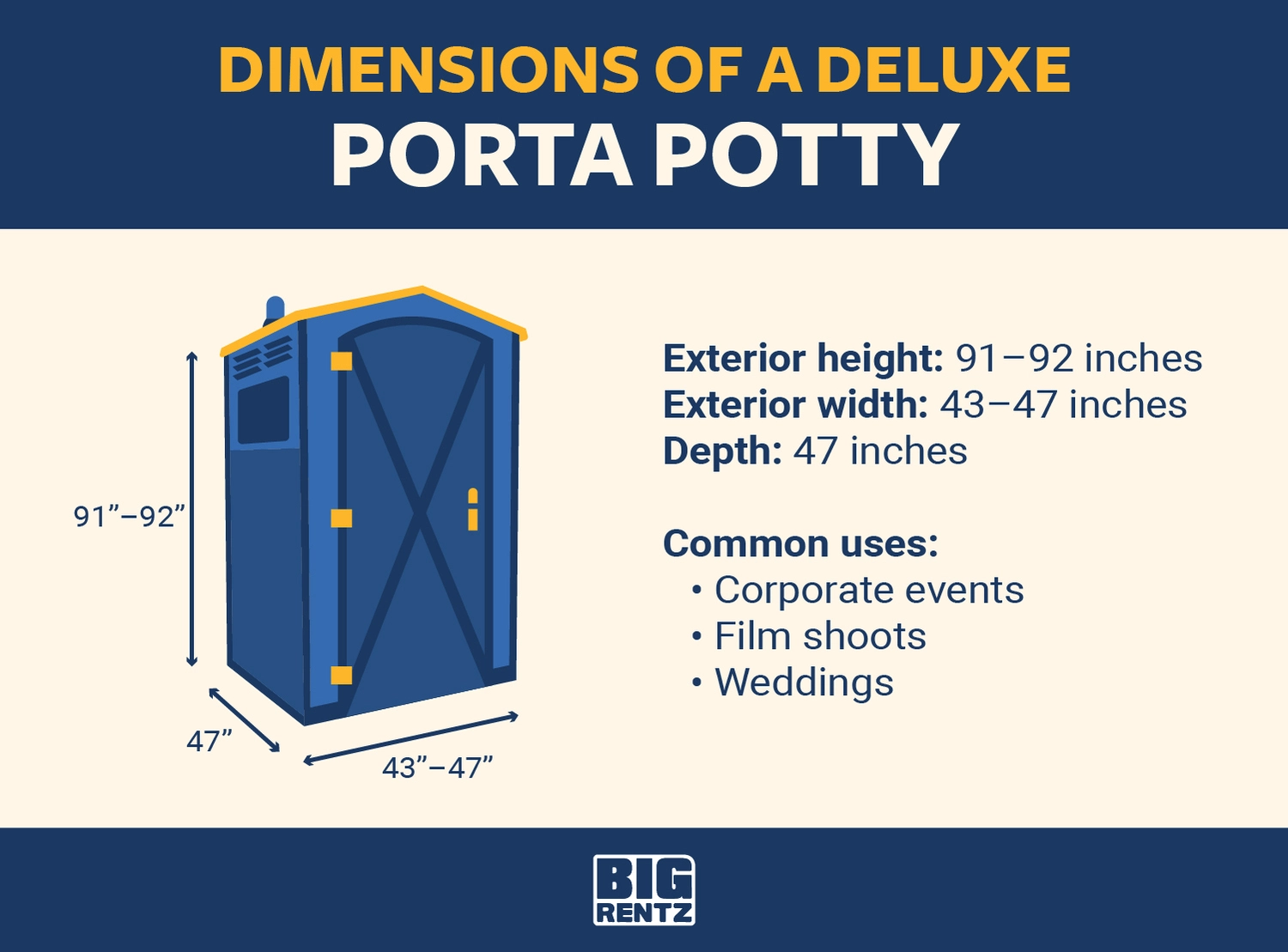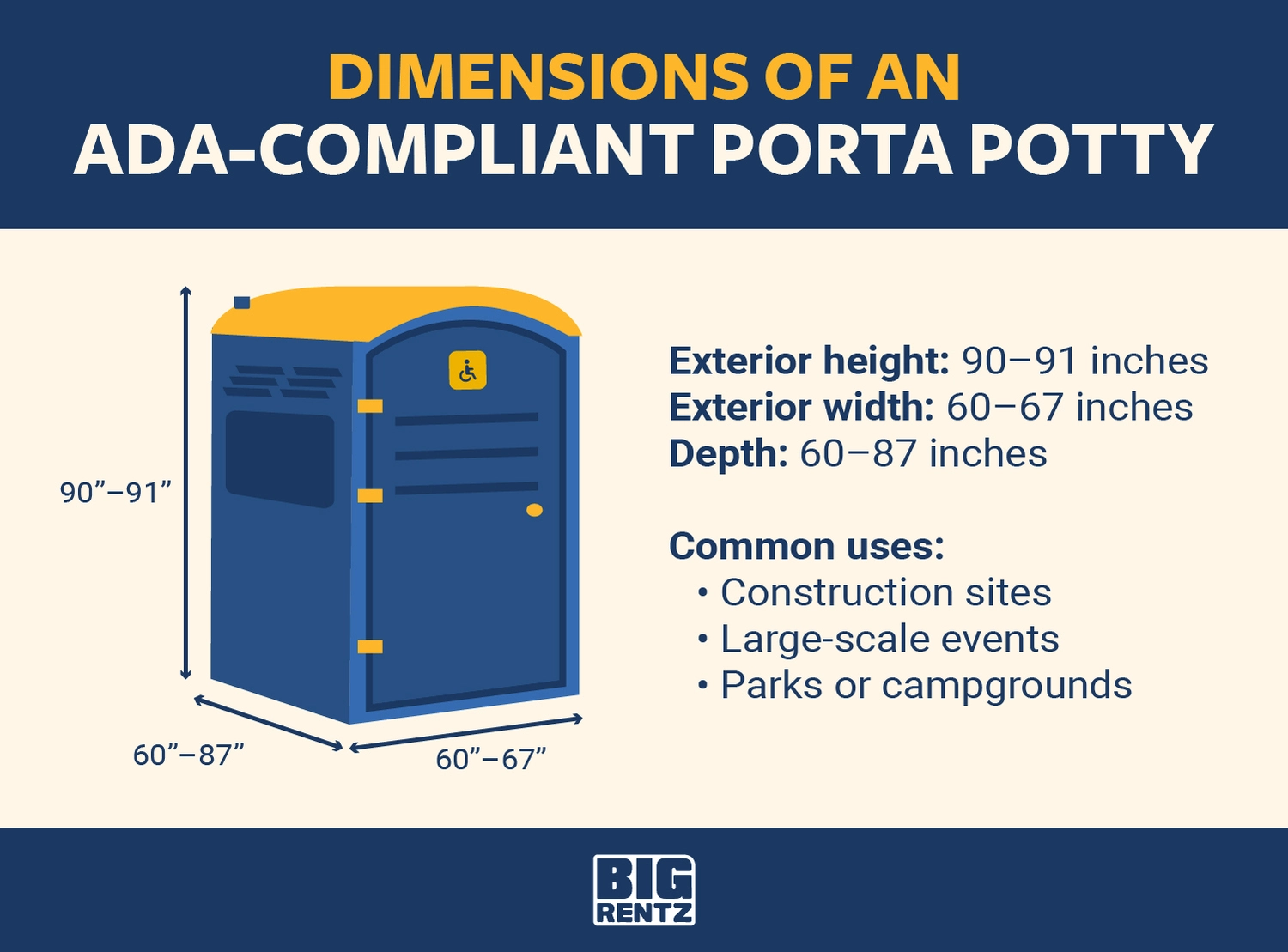Portable toilets, commonly known as porta potties, can provide convenient bathroom access for a variety of needs, from weddings and concerts to construction sites. Sometimes porta potties are provided as a matter of convenience and sometimes they are required by law.
If you are planning to install porta potties, you may be wondering how big they are and how much space you need. A standard porta potty typically measures around 90 inches tall and 43 inches wide. The exact dimensions, however, may vary depending on the brand and type of porta potty you use. Deluxe porta potties and units that comply with the Americans with Disabilities Act (ADA) will be larger.
This post covers porta potty dimensions, common types of porta potties, and the porta potty requirements and amenities you may want to consider.
Table of Contents
- How Porta Potties Are Measured
- Dimensions of a Standard Porta Potty
- Dimensions of a Deluxe Porta Potty
- Dimensions of an ADA-Compliant Porta Potty
- Dimensions of a Two-Stall Trailer Porta Potty
- Number of Porta Potties Required for a Construction Site
- Number of Porta Potties Required For an Event
- General Porta Potty Requirements
How Porta Potties Are Measured
Porta potties are typically measured by their exterior height (from the bottom end to the top end) and width, but there are other dimensions that you may want to consider when renting portable restrooms for your event or jobsite. Other measurements include depth, weight, and waste tank capacity.
The following are typical measurements for different kinds of porta-potty units. Please note that these are estimated numbers and that exact dimensions may vary depending on the brand and type of porta potty you use.
Common Porta Potty Dimensions
| Exterior Height (in) | Exterior Width (in) | Depth (in) | Tank Capacity (gal) | Weight (lb) | |
| Standard | 88–90 | 43–44 | 46–48 | 60–70 | 160–200 |
| Deluxe | 91-92 | 43–47 | 47 | 60-70 | 160-200 |
| ADA-Complaint | 90–91 | 60–67 | 60–87 | 35–50 | 250–400 |
| Two-Stall Trailer | 126–132 | 120–198 | 100–102 | Up to 700 | Up to 5,300 |
Dimensions of a Standard Porta Potty

Standard portable toilets are typically 88 to 90 inches tall, 43 to 44 inches wide and 46–48 inches deep. They are the smallest and most cost-effective porta potty among the available options. Standard porta potties usually have about a 70-gallon tank, which can withstand 150 to 200 uses.
Standard porta potties typically feature a toilet and a toilet paper dispenser. Some models may have a urinal. These basic porta potties do not have as many features as more deluxe units, such as a sink, spacious interior, or hand sanitizers, but the holding tank capacity is similar to that of the deluxe. Due to their lightweight and compact design, they are the most common type of porta potty and can be used in many settings.
This model may be the right choice for you if you require a large number of porta potties and only require basic amenities.
Common uses:
- Construction sites
- Remodeling projects
- Festivals and carnivals
Dimensions of a Deluxe Porta Potty

Deluxe porta potties typically measure 91 to 92 inches tall, 43 to 47 inches wide, and 47 inches deep. You’ll find the insides of a deluxe to be roomier than standard porta potties, and they also provide a few more amenities. The tank is typically the same size as a standard porta potty, at around 70 gallons.
Deluxe porta potties usually feature a hand sanitizer, an in-unit hand washing station, and more interior space. They may be best if you need built-in hand washing and sanitizer stations. These are especially useful at events where you’ll have parents taking small children to the bathroom.
Common uses:
- Corporate events
- Film shoots
- Weddings
Dimensions of an ADA-Compliant Porta Potty

ADA-compliant toilets are 90 to 91 inches tall, 60 to 67 inches wide, and 60 to 87 inches deep. They have the widest interior space among all porta potties and give people with disabilities more room to use the restroom. The ADA also requires that you have at least 1 compliant porta potty in each cluster of 20 units.
ADA-compliant porta potties also have other features, including wheelchair accessibility with ground-level access, handrails, in-unit washing and sanitizing stations, toilet paper holders, and a privacy latch.
Common uses:
- Construction sites
- Large-scale events
- Parks or campgrounds
Dimensions of a Two-Stall Trailer Porta Potty

Two-stall trailer porta potties provide more luxury amenities like HVAC and flushing toilets. They are typically attached to a trailer, which allows for easier mobility.
Restroom trailers are much wider than standard porta potties because there are two units instead of one, which you can use to accommodate both men and women. Two-stall porta potty trailers can hold up to 700 gallons of waste and have enough capacity to accommodate up to 400 guests.
Two-stall trailers typically feature a complete flushing toilet, urinal, sink, heating and A/C, decorative walls and flooring, and a soap dispenser.
Common uses:
- Fairs
- Film shoots
- Weddings
Number of Porta Potties Required for a Construction Site
The Occupational Safety and Health Administration (OSHA) sets safety standards for workers, and that includes sanitation and restroom requirements. If your construction site includes 20 workers or less, you should have at least one toilet facility to meet OSHA Standard 1926.51(c)(1). If your jobsite has anywhere from 20 to 40 workers, you’ll need one toilet seat and one urinal. The same goes for bigger workforces; one toilet seat and one urinal for every 50 workers above 200.
| Number of Employees | Minimum Number of Facilities |
| 20 or less | 1 |
| 20 or more | 1 toilet and 1 urinal for every 40 workers |
| 200 or more | 1 toilet and 1 urinal for every 50 workers |
Number of Porta Potties Required For an Event
The number of porta potties needed for a concert, wedding, or other event usually depends on the number of people attending. However, according to the Portable Sanitation Association International (PSAI), the number of toilets needed per person can change depending on the event duration and whether you include food and beverages. The PSAI recommends adding 10% to 20% more porta potties if you’re serving food/beverages.
General Porta Potty Requirements
Porta potties must meet a number of legal requirements regarding cleanliness and accessibility.
- Porta potties must be sanitary. Per OSHA guidelines, employers must regularly inspect porta-potty conditions and schedule routine cleaning. OSHA also requires event organizers to provide hand soap, towels, and hot/cold running water at handwashing stations.
- Porta potties must be close in proximity. Toilet facilities shouldn’t be more than 10 minutes away from where workers are assigned to work.
- Porta potties must be accessible. According to the ADA, 5 percent (or 1 out of every 20) of the total number of porta potties must be accessible, meeting requirements such as ramps, turning space, and grab bars.
ADA-compliant bathrooms must have the following:
- Doors with 32-inch minimum openings
- Accessible routes and entrances
- Compliant ramps necessary for changes in level
- Entrance landings sized to accommodate door maneuvering clearances and ramp landings
- Grab bars mounted on the walls beside and behind the water closet
- Required clearances at fixtures and other elements, turning space, and door maneuvering clearance
Consider Any Additional Porta Potty Amenities
Make sure to consider any amenities you may need such as handwashing stations, ramp access for ADA-compliant porta potties, or any necessary additional supplies. When you rent a porta potty, understand what’s included and the required maintenance schedule to ensure that your porta potties work properly and so your guests or workers are comfortable and experience sanitary conditions.
- Sanitary supplies (toilet paper, towels, and hand sanitizers): Proper sanitation supplies are essential for comfort and good hygiene.
- Odor control additives and sprays: Spray air fresheners and other types of odor-control chemicals can help keep bad smells at bay.
- Sanitation truck: Specialized trucks are equipped with hoses and pumps to empty porta potty waste tanks.
- Blue dye: Liquid blue dye may be mixed into toilet water to hide the appearance of waste and debris. It also turns green after mingling with a sufficient quantity of waste, indicating to sanitation workers that it’s time to replace the chemicals.
- Fragrances: Porta potty toilet chemicals usually contain fragrances to mask smelly odors in the unit.
- Surfactants: Surfactants reduce surface tension, helping cleaning solutions and fragrances better penetrate waste materials.
- Biocides and enzymes: These substances help prevent the growth of bacteria and speed up decomposition of waste, reducing odor and making disposal easier.
- Cleaning tools (towels, mops, or brushes): Sometimes there’s no substitute for good old-fashioned elbow grease, which is where cleaning implements like sponges and scrub brushes come in.
To find the exact dimensions or cost of a porta potty, speak to a BigRentz rental expert today at (888) 325-5172. We also have a variety of other rental equipment available for your next job or event, including dumpsters, storage containers, and generators.